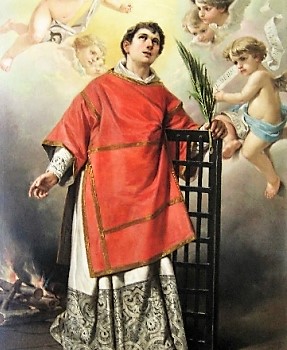
St Lawrence is a widely venerated saint of the Roman Catholic Church. Records don’t mention much about his life. He is one of those martyrs under "odium humani generis” (hatred of the human race) carried out by the Romans during the first and second centuries. He is the patron of Rome, students, miners, tanners, chefs, poor, firefighters, sailors and comedians to name a few.
Martyrdom of Deacon Lawrence
Lawrence, a Spaniard, was one of the seven deacons working under Pope Sixtus II who were martyred during the persecution by Emperor Valerian in 258. Lawrence was the custodian of the material goods of the Church, and was responsible for the distribution of alms to the poor. When Lawrence knew he would be arrested just like the Pope, he gathered the poor/widows/orphans and gave them all the money he had on hand, selling even the sacred vessels of the altar to increase the sum. When the prefect of Rome heard this, he imagined that the Christians must be having a considerable treasure. He came in and ordered Lawrence to surrender the Church riches to the Emperor.
Lawrence asked for some time to hand over the treasures. After three days he gathered a great number of blind, lame, leprous, orphaned, and widows. When the prefect arrived, Lawrence showed him the treasure of the Church. The prefect was so angry that he ordered Deacon Lawrence to be burned alive, in public, on a griddle. He had a great gridiron prepared with coals beneath it and had Lawrence’s body placed on it. After the severe torment over the fire, the legend concludes that he made the cheerful remark, “It is well done on this side. Turn me over!” From this statement, St Lawrence derives his patronage of cooks, chefs, and comedians. Before his death, he prayed that Rome might be converted to Jesus, and prayed that the Catholic faith would spread all over the world. Lawrence died on August 10, 258, and was buried in a cemetery on the Via Tiburtina(Italy). Later, Emperor Constantine erected a Basilica that became one of the seven principal churches in Rome and a favourite place for pilgrimages.
Miracles after his Martyrdom
Many miracles through the intercession of St Lawrence are documented in the Gregory of Tours (538–594). However, two important miracles are worth mentioning. A priest named Fr Sanctulus was rebuilding the church of St Lawrence, which had been attacked and burnt, and hired many workers to accomplish the job. At one point during the construction, he had nothing to feed them. He prayed to St Lawrence for help, and looking in his basket he found a fresh loaf of bread. It was too small to feed the workers, but in faith, he began to serve it to them. While he broke the bread, it multiplied that all his workers could feed themselves for ten days.
In another incident, a priest was repairing the Church of St Lawrence, and one of the essential beams was found to be too short. The priest prayed to St Lawrence, who had seen the well-being of the poor, to help him in his poverty of lumber. Miraculously the beam grew in length significantly that it had to be cut to the size. The priest cut the rest into pieces and distributed it among the faithful, and by venerating the wood many were healed.
Saint’s devotion in Goa
The feast of St Lawrence is celebrated on August 10 at Sinquerim, Agaçaim, and Arossim. The Portuguese built two churches dedicated to St Lawrence- one in Sinquerim(Aguada) in 1643, at Agaçaim in 1565, and a chapel in Arrosim village (Cansaulim) in 1598. The Sinquerim church, which is located on the hilltop has a magnificent view of the Mandovi River, is dome-shaped that portrays wonderful artworks of the risen Jesus Christ and a legion of angels. The main altar is a typical Baroque retable, with three Solomonic columns flanking a shell-headed niche which houses the statue of St Lawrence, with an angel on either side. Another niche is raised to a higher level and houses the statue of Nossa Senhora da Boa Viagem, with the statues of St John the Baptist and Archangel St Michael on either side.
The feast day is traditionally linked to the end of the rainy season. Among the three places, the feast held at Sinquerim has a ritual. The priest symbolically blesses the entrance of the Mandovi River where a sand bar is formed during monsoons. After the blessings, the Aguada sand bar disappears and the maritime traffic resumes. In olden days a symbolic ritual was held wherein a ribbon was tied from the Cabo at Dona Paula to the Aguada Fort, and the General of the rivers would go midstream in a boat and cut it with a sword to declare the navigation channel open for ships. This feast mostly attracts the newly wedded couples as the Saint’s humour and light-heartedness during the intense persecution and suffering are related to every married couple who undergoes trials and difficulties together.
(The writer is a teacher Grade-I at R & P Salkar HSS of Arts & Commerce, Chorão, and a catechist at St Michael Church, Taleigão)